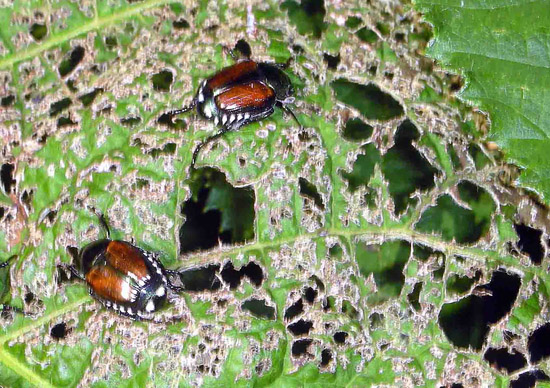Issue 9, June 18, 2010
Japanese Beetle
Japanese beetles are emerging throughout the state. The warm spring weather in northern and southern Illinois has probably resulted in their emerging early in the northern two-thirds of the state. This is the normal time for their emergence in southern Illinois.
Male beetles emerge before the females and are attracted to turf areas where female adults are about to emerge. They try to mate with her as she emerges from the soil, with many males trying to mate with each female. This causes a phenomenon called balling, where a ball-shaped mass of males forms on the turf in their efforts to mate with a single female in their midst.

Emerging females fly to host plants to feed, being followed by the males who will continue to mate with the females for several weeks. Although Japanese beetles are known to feed on about 200 kinds of plants, they prefer smartweed, linden, crabapple, birch, willow, Japanese maple, rose, cherry, grape, raspberry, blackberry, and currant. Unlike many insects, they prefer to feed in the sun, being most common on the upper side of the leaves at the top of the tree or shrub.
Two types of damage are caused. They feed through the upper leaf surface, consume the interior of the leaf, and leave the lower surface intact. This is called window-feeding. The exposed lower leaf surface is initially whitish, but soon turns brown as the exposed cells die. They will also eat holes through the leaf, frequently leaving only the major leaf veins. This is called leaf skeletonization; only the veins or skeleton of the leaf are left behind. Due to the beetles' preference for sunny locations, damage will appear as brown leaves or sparse foliage at the top of the tree and progressively work its way down as feeding continues.

The beetles change hosts about every three days, being attracted to plants with damaged foliage, particularly that damaged by other adult Japanese beetles. The beetles are present for about six weeks, so plant damage continues to increase. Due to this tendency to attack previously attacked plants, control of leaf damage early in the flight season is the most critical.
An interesting habit of adult Japanese beetles is that when they are disturbed in late afternoon through evening, they tend to fold their legs and drop from the plant. Earlier in the day, they tend to fly away. This habit makes it easy to hand-pick them. Partially fill a wide-mouth jar, such as an empty peanut butter jar, with rubbing alcohol or soapy water. Hold it under the beetle, poke at it, and the beetle will drop into the liquid where it will be killed. Homeowners that do this every other evening or so for the first week or two of emergence will greatly reduce the feeding damage over the flight period to their roses, shrubs, and small trees.
Spraying every two weeks with carbaryl (Sevin), cyfluthrin (Tempo), or other labeled pyrethroid insecticide will also provide control. With the beetles out for about six weeks, this will require three sprays. If the client is unwilling to pay for three sprays, the first spray will provide the most plant protection for the cost and effort. Because the beetles primarily cause only aesthetic damage, not causing obvious health problems to the plants, leaving plants untreated that are less important to the landscape's appearance is an option. When the beetles change host plants every three days, they tend to fly at least one-half mile to a new host. Leaving untreated hosts in the landscape is unlikely to cause an increase to treated trees or to result in an increase in egg-laying and subsequent white grubs in the nearby turf.
Japanese beetle traps are available that attract male beetles with a sex pheromone lure and female beetles with a floral lure. These have been shown repeatedly to increase the amount of foliar damage in the area around the trap. The trap attracts beetles from a large area, but many feed on nearby plants rather than going directly to the trap.--Phil Nixon
Author:
Phil Nixon